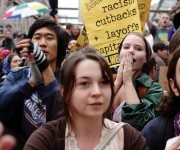 Photo: Paul SteinWhat are cities for, anyway?
Photo: Paul SteinWhat are cities for, anyway?
There are as many answers as there are people who love (or hate) cities. They are engines for economic growth, if you ask economist Ed Glaeser. They are breeding grounds for human innovation, if you ask physicist Geoffrey West. If you’re a dictator or a despot — or a Wall Street fat cat — you might worry about their tendency to harbor radicalism and social unrest.
Fundamentally, cities exist to serve and facilitate the fulfillment of human needs — physiological, social, and intellectual — and when those needs are unmet, they are often the first places to react. They are the places where human change is accelerated. And that’s why they are the center of the Occupy Wall Street movement. As Matt Yglesias wrote on the Atlantic Cities site a couple of weeks ago, “Nobody wants to occupy the strip mall or the office park or the park and ride lot.”
Nope. People — of all ages, but many of them young — want to occupy cities. Fed up with a broken system that delivers little of what it promises, they are using urban public space as an open-source laboratory for social change. And as much as established media and pundits insisted at first that they had nothing to gain with their open-ended effort, they kept going. Because the way things are these days, they actually don’t have anything to lose.
Active engagement with the city as a medium for social change isn’t confined to Occupy Wall Street. Back in October, I attended an event called the Tactical Urbanism Salon, where a group of active urbanist thinkers and doers, mostly in their 20s and 30s, gathered to talk about ways to make cities better using targeted interventions that are often low-cost and easy to implement quickly. (I’ve written about the Tactical Urbanism concept here before; full disclosure: one of the group’s founders, Aurash Khawarzad, is now a friend and coworker of mine). These actions and interventions include improvised street seating, pop-up parks, window farms, and the like. Sometimes they’re done in partnership with government, but the impetus and creative energy is coming from the bottom up.
In the Tactical Urbanism approach, knowledge is shared. Failure is expected and seen as a creative force, rather than as something to be feared. Input from others is welcome. Want to brainstorm about vertical farming? Share ideas about bus-top gardens? You’re welcome to contribute. In a significant departure from the attitude of previous generations of entrepreneurs and activists, there’s not a lot of proprietary grasping going on. It’s a creative commons approach to the physical commons.
Social consciousness is an integral part of this new urban activism. One of the speakers at the Tactical Urbanism event, which was held in Long Island City’s Flux Factory, was Chiara Camponeschi, founder of an online urbanist resource called The Enabling City. Camponeschi documents grassroots urban innovations from tool-lending libraries to food redistribution programs to the salvage of neglected spaces.
Camponeschi asked this: “If cities aren’t ‘enabling,’ then what are they, and who are they helping?”
It’s an idealistic question. Some might even call it naive. But it seems entirely appropriate in light of OWS.
There was, not surprisingly, a lot of talk about the Occupy movement that day, including a work session on the town planning process at the Zuccotti Park site. And although there was definitely a diversity of opinion — some were skeptical, many others embraced the movement wholeheartedly — there was an overall feeling that the movement is speaking a generational truth.
The people around me in that room were hard-working, energetic, innovative, mostly young people who were proceeding with their plans and ideas for making cities better with little or no expectation that they were going to get help from governments, corporations, or any other established entities. Instead, they look to the city itself — its people, its infrastructure (crumbling or not), its capacity to foster human interaction.
These are people enabled by the city to do the work they care about — and in their case, the work is to nurture, heal, and grow the very city that makes it all possible.
Right now, all around the country, people are taking “nothing” — the streets of their cities, their own frustrated expectations, the kindness of strangers — and building something. It’s not a flawless effort. There are real questions about the impact on the surrounding neighborhoods, about the exclusion of certain classes of people, about the ability of all speakers to be heard. But after so many years of apathy and disengagement from the left, it’s kind of wonderful to watch.



